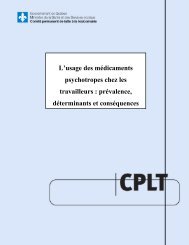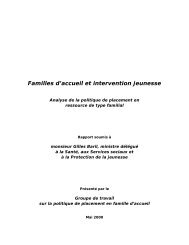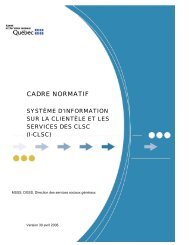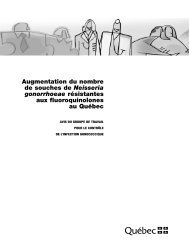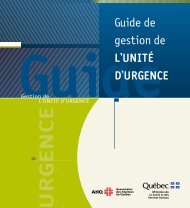De l'innovation au changement - Gouvernement du Québec
De l'innovation au changement - Gouvernement du Québec
De l'innovation au changement - Gouvernement du Québec
You also want an ePaper? Increase the reach of your titles
YUMPU automatically turns print PDFs into web optimized ePapers that Google loves.
Projet 16<br />
Impact of a discharge coordinator on the sucessful discharge<br />
of elderly patients from the emergency department (ED),région de Montréal<br />
Impact d’un coordonnateur des congés <strong>au</strong> département d’urgence (DU)<br />
sur le succès <strong>du</strong> congé des patients âgés<br />
6. POTENTIEL DE GÉNÉRALISATION<br />
6.1 Pérennité The success of the model continues to be demonstrated by the acceptance and the investment by hospital administrators into the creation,<br />
in October 2000, of a new position of nurse discharge coordinator dedicated to the ED. The nursing intervention model, designed for the<br />
study, continues to be played out in practice. The efforts now are concentrated on patients whose characteristics were identified in the<br />
study as being at risk. The study has also identified key characteristics of patients that make them at high risk for revisit. Continuity of care<br />
beyond the ED visit continues. Patients who are at higher risk are provided with follow up phone calls the next day and all patients are<br />
given the nurses business card. Patients continue to contact the discharge nurse seeking clarification of information, assistance with<br />
appointments and community services or simply reassurance. The network integration team also continues to meet on a regular basis.<br />
6.2 Conditions nécessaires Future Directions: We believed that the discharge needs of the “healthy” elderly are often underestimated. The project was, therefore,<br />
designed to address the discharge needs of all patients over the age of seventy-five. With the time and resource constraints of the project,<br />
it was unrealistic to target this entire geriatric population. Therefore, the results of the study may have been limited by sample selection, in<br />
that, many patients recruited were not considered frail. Future studies using a risk assessment tool to target the more frail elderly<br />
identifiable would be suggested.<br />
Aspects of successful discharge planning were identified. These included adequate time to assess and address the needs of the<br />
patient/family unit, building close and trusting ties with the community agencies, and most importantly the availability to the patient by<br />
phone to discuss problems/concerns.<br />
The successful implementation of a nurse discharge coordinator depends on a number of factors. First and foremost, is the integration of<br />
this indivi<strong>du</strong>al into the ED medical/nursing team. The ED staff needs to go through a learning curve to understand and value the role of the<br />
discharge nurse. Early in the study, recruited patients were lost bec<strong>au</strong>se the ED staff did not notify the discharge nurse that the patient was<br />
ready to go home.<br />
Communication with the community agencies is vital. The discharge coordinator must act as that all important link between the hospital<br />
and community.<br />
Much of the work of the discharge coordinator is away from the bedside. The discharge coordinator must have a dedicated workspace<br />
away from the bustle of the ED where the patient/family may be interviewed and not be pressed for new access to the patient’s stretcher. A<br />
dedicated telephone and computer to access patient information and transmit referrals was found to be indispensable.<br />
6.3 Avantages généralisation Puisque le processus de planification des congés est déjà bien assimilé et utilisé largement pour la clientèle hospitalisée, l'implantation de<br />
cette intervention à grande échelle, tant dans les départements d'urgence de Montréal que dans ceux <strong>du</strong> reste <strong>du</strong> Québec et des <strong>au</strong>tres<br />
provinces, semble réaliste et prometteuse.<br />
The impact of the intervention, however, goes beyond the two-week study period. Patients with trivial appearing complaints often have<br />
serious underlying health and social needs that are unmet. These patients often slip through the cracks in a busy emergency department.<br />
A nurse discharge coordinator would have the time to help identify and address these needs. These patients, if needed, would then be<br />
referred back to the community into a “guichet unique” system.<br />
Cost Effectiveness : Although the study did not include a cost analysis, certainly the re<strong>du</strong>ction in return visits to the hospital should<br />
85





